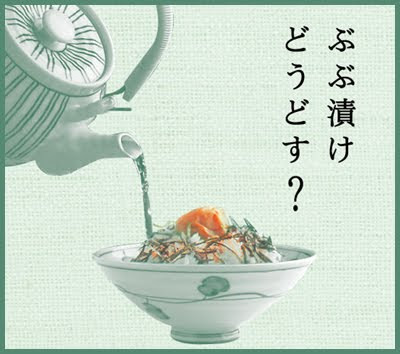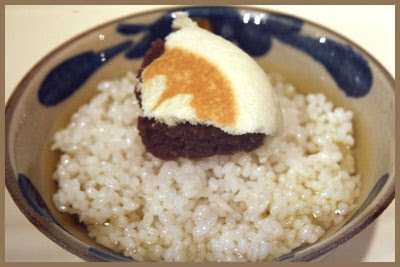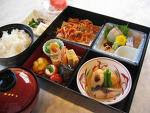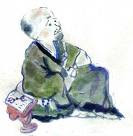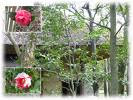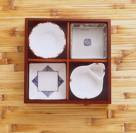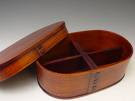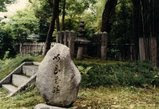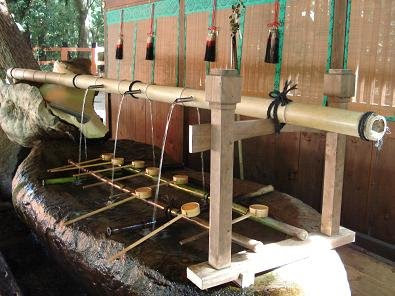::::::::::::::::::::::::::::::::::::::::::::::::::::::::::::::::::::::::::::::::::::::::::::::::::::
Temple and Shrine Festivals and Food
Some Japanese temples and shrines have special festivals, where food is in the center.
The ones listed here are all kigo for haiku, since they are performed on special occasions during the year.
This LIST is part of Ceremonies and Festivals of Japan
SAIJIKI
A temple is a place for Buddhist worship.
Temple, Buddhist Temple (tera, -ji) Japan
A shrine is a place for Shinto worship.
Shrine, Shinto Shrine (jinja, miya, guu) Japan
:::::::::::::::::::::::::::::::::::::::::::::::::::::::::::::::::::::::::::::::::::::::::::::::::::::
Cooking soup with big radishes
usually in a temple
kigo for mid-winter
Daikodaki (daikotaki) 大根焚 Cooking large radishes
Temple Sansen-In, Kyoto, Feb. 10 - 13
三千院の初午大根焚き, 年2月10日~13日
..... Daikon, Radish
. Sanzenin 三千院 Sanzen-In .
Joodoo-E Ceremony 成道会 Daikodaki 大根焚
cooking radish soup, Jodoe
At Temple Senbon Shakado 千本釈迦堂, Daihoo-Onji 大報恩寺 Kyoto

5000 radishes are cooked and served in 10.000 portions for two days to the parishers to celebrate the death day of Buddha on December 8, when Shakyamuni Buddha reached the final nirvana.
A bowl of soup costs 1000 Yen.

Since the Kamakura period, monks write special sanskrit letters on the radishes to ward off evil.
On December 8. A ceremony "to bring winter to Kyoto".
「 千本釈迦堂・大根焚きと応仁の乱の痕跡を求めて 」
千本釈迦堂京都市
CLICK here for PHOTOS
demons in distress ...
a bowl of steaming soup
brings good luck
Gabi Greve, December 8, 2008
It was a very cold morning this year in Kyoto and the steam curling out of these many little bowls rising in the air could well frighten away anyone with a bad conscience.
Senbon Shakado 千本釈迦堂(大報恩寺)
上京区七本松通今出川上ル溝前町1034
Clay bells with O-Kame おかめ土鈴


CLICK for ryoomen 両面おかめ土鈴 O-Kame with two faces
. Kyoto no dorei 京都の土鈴 clay bells from Kyoto .
.............................................
念仏や兵戈無用の成道会
nenbutsu ya heika muyoo no joodoo e
praying to Amida Buddha !
on the day of nirwana
we need no weapons
Haiku by : Uuu 烏有(ウユウ)
Daikotaki at temple Sanpo-Ji, Nichiren-sect
三寳寺 (さんぽうじ)Kyoto
.................................................................................
Narutaki no daikotaki 鳴滝の大根焚 (なるたきのだいこたき)
cooking radish soup at Narutaki
..... daikotaki 大根焚(だいこたき)
On December 9 and 10, at temple Narutaki Ryootokuji in Kyoto 京都鳴滝了徳寺.
Ryotoku-Ji is situated in an area called Narutaki. Today it also has a Buddhist university.
The ceremony is in memory of Saint Shinran Shonin by the Hoo On Koo 報恩講 prayer group.
People line up since early morning to get a bowl of aokubi daikon soup with a bit of agetofu. If they eat it, they will not get an apoplexy or palsy.

. Saint Shinran 親鸞 .
::::::::::::::::::::::::::::::::::::::::::::::::::::::::::::::::::::::::::::::::::::::::::::::::::::
Benten, Benzaiten 弁天 / 弁財天 and food
Botamochi Jizo ぼた餅地蔵 Jizo Bosatsu, Botamochi rice cakes
Chinowagayu, chinowa-gayu 茅の輪粥 rice porridge
chi no wa kayu, served on the last day of the sixth month.
Godairiki Mochi at Temple Daigoji 五大力餅 Kyoto
Nikkoo Goohan-Shiki 日光強飯式Gohanshiki.
Ceremony of eating large bowls of rice
Gesai no on kayu 解斎の御粥 End of mourning rice gruel
Hassaku no iwai 八朔の祝 Hassaku Harvest Festival.
hassaku gama 八朔釜. Rice Gruel, O-bana no kayu 尾花の粥
Botamochi Rice Cakes (Botamochi) "Ricecakes in difficult times" Gonan no mochi 御難の餅 (ごなんのもち)
Honen Matsuri (Hoonen Matsuri 豊年祭) and "sex" food
Kayu 粥 Rice Gruel and related ceremonies during the year
for example
gruel at the tenth night, juuya gayu 十夜粥(じゅうやがゆ)
"Gruel for Priest Chi-E", Chie gayu 智慧粥
offering gruel to the poor, kayu segyoo 粥施行(かゆせぎょう)
Azukigayu 小豆粥 (あずきがゆ) Rice gruel with small soybeans *..... rice gruel on the 15th, juugonichi gayu 十五日粥(じゅうごにちがゆ)
and a few more kigo with rice gruel:mochi put in rice gruel, kayu bashira 粥柱 (かゆばしら)"rice gruel stick" kayuzue 粥杖 (かゆづえ)kayu no ki 粥の木(かゆのき)..... kayugi 粥木(かゆき)fukuzue 福杖(ふくづえ)..... iwai boo、祝棒(いわいぼう)divination with rice gruel, kayu ura 粥占 (かゆうら)
Hagatame はがため Teeth strengthening Ceremony (hagatame) ..... rice cakes for strengthening the teeth
Hochoshiki, hoochooshiki 包丁式 Kitchen Knife Ceremony
God of Cooking, Iwakamutsukari no Mikoto and Knife Rituals.
磐鹿六雁命。April 18
Hooroku Jizo ほうろく地蔵 with an earthen pot on his head and Mibu Kyogen 壬生狂言
Juuhachi Gayu 十八粥 Rice Gruel
Kayutsuri 粥釣, 粥つり かゆつり "Fishing for rice gruel"
Kenpai Shiki 献盃式 Ceremony of drinking Rice wine (sake) sake in memory of Shinran Shoonin
Toso 屠蘇, ritual rice wine
kiganmai 祈願米 "consecrated rice" kigan mai
eingesegneter Reis und andere Speisen
Kyuuri fuuji きゅうり封じ / 胡瓜封じ cucumber service
Mamori, omamori, o-mamori お守り Talismans, amuletts and food
mayudama 繭玉 (まゆだま) "cocoon balls"
Mochi or dango for the New Year celebrations of the Silk protecting deities
Mitarashi dango dumplings and Shimogamo Shrine Kyoto.
御手洗団子(みたらしだんご) 下賀茂神社
. Naorai 直会 (なおらい)ritual Shinto banquets .
Sen dango matsuri 千団子祭(せんだんごまつり)festival of the one thousand dango dumpings
at temple Mii-dera
and other kigo/ceremonies with DANGO dumplings
Shirumori Jinja 汁守神社 Shrine Shirumori, the protector of soups
Ukemochi no Mikoto 保食命. and
Meshimori jinja 飯守神社 Protector shrine of cooked rice
Shishigatani Kabocha Kuyoo 鹿ヶ谷かぼちゃ供養 Pumpkin memorial service, at Temple Anraku-Ji in Kyoto
Yakimochi Fudoo Son 焼き餅不動尊in Gunma
Zenbonzuki 千本搗 Ceremony of preparing 1000 rice cakes.....
at the temple Mizumadera (大阪府貝塚市水間寺)
In honour of the Venerable Gyooki
Zuiki matsuri ずいきまつり(芋茎祭) Vegetable Decoration Festival
Kitano Tenmangu, Kyoto in October
::::::::::::::::::::::::::::::::::::::::::::::::::::::::::::::::::::::::::::::::::::::::::::::::::::
Buzen Kagura, at the Shrine Kibune Jinja
貴船神社, 豊前神楽
Iwado Kagura of Buzen, 岩戸神楽 Kyushu
kifune shrine
During the autumn performance of four months every day at the Kibune Shrine, dances are performen on the request of the people.
One dance is BON 盆神楽, the tray.
A priest/dancer/acrobat takes two flat plates filled with rice grains of this harvest and dances around, suddenly lifting the two plates vertically in front of his face and turning so fast that not one grain of rice is spilled on the ground! Turns to the left, to the right ... many times up and down with the rice plates. Even both plates balanced in one hand, lifting it up too and spins round like crazy not to loose one grain.
Three Gods Dance 三神神楽
This dance involves daifuku mochi, rice cakes filled with sweet bean paste anko.
The God of the Mountains is asked by the God of the Sea and the God of the Village (sato no kami 里の神) to share this food with all, so he breaks the bun into many small parts, gives a bite to an onlooker and smears the bean paste on his/her cheek for good luck in the coming season (fuku o tsukeru).
In another dance 立神楽 not related to food, the performer climbs up a bamboo pole of 10 meters, picks up some prayer flags from there and comes down sliding on a rope, performing acrobatic tricks on the way down.
*****************************
Things found on the way
my Library
宗教や神話の影響を受けた食文化
and
Basics about Japanese Food
*****************************
HAIKU
*****************************
Related words
***** Ceremonies and Festivals of Japan
SAIJIKI
***** WKD : Regional Dishes / WASHOKU
:::::::::::::::::::::::::::::::::::::::::::::::::::::::::::::::::::::::::::::::::::::::::::::::::::


